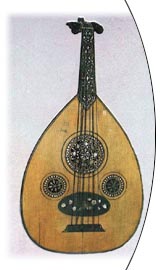Ud
 This is a large-bodied, short-stemmed stringed instrument played not only in Türkiye but also in the entire Arab world, including Tunisia, Morocco and Algeria, where it is known by the same name, as well as Iran and Azerbayjan. In Iran it is known as the ‘barbat.’ It is very similar to the European lute.
This is a large-bodied, short-stemmed stringed instrument played not only in Türkiye but also in the entire Arab world, including Tunisia, Morocco and Algeria, where it is known by the same name, as well as Iran and Azerbayjan. In Iran it is known as the ‘barbat.’ It is very similar to the European lute.
There are almost no structural differences between the ud used in Türkiye and those played elsewhere. Hoever, it must be made clear that the Arab ud tends to be slightly larger, and can have two small holes instead of one large one on the chest. These holes are invariably decorated with a single rose, whether the ud be Turkish, Arab, Iranian, Armenian or Greek. Apart from two minor changes, the ud has remained unchanged for the last 1,000 years. The body of the ud, which sits in the player’s lap, is made up of up to 20 layers of wood in the shape of a crescent. The short, flat stem is attached to the body by means of a wedge. It gets narrow as it approaches the pegs, and is some four fingers wide where it joins the body. The peg area is at 45 degrees to the stem, and forms an S shape, where the pegs are attached. All but one of the strings are double. The bottom two pairs used to be made of gut, although they are now made of fishing line. The other strings are made of silk covered with silver or copper. Each string goes over a bridge attached to the body (which is also the main bridge in the ud), and joins its own peg. The body of the ud is about 1 mm. thick, and made of straight-grained spruce. The supporting strips under the chest are known as the ‘balkon.’ The way they are set out affects the sonority of the instrument.
In the old days, strings were made of cat gut, or silk covered with silver, known as ‘silver plaited strings.’ Nylon has now replaced gut. The ud used to be played with chicken and eagle feathers, and some performers used a plectrum made of hard leather or cherry bark. Plastic plectra are now preferred, however.
The body of the ud is placed on the player’s lap, and squeezed from the top by the right arm, the plectrum being held in the right hand. The strings are plucked by the fingers of the left hand.
Although it was popular in various periods, it took its definitive place among the instruments of Ottoman music in the second half of the 19th century.
Sound of the ud/Yorgo Bacanos – Selmek Taksim (4.00MB)